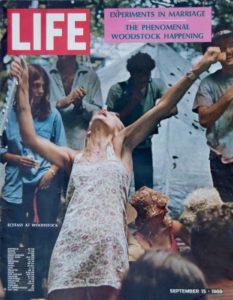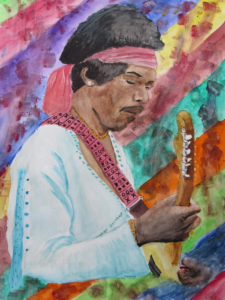
The tensions of the 60’s erupted in various ways. The most unfortunate were the riots, notable ones occurring in Watts, California, Detroit, Newark, Chicago, and Washington D.C. More peaceful statements were made by sit-ins and marches.
But an amazing statement was made in the form of a three-day music festival on an upstate farm owned by dairy farmer Max Yasgur.
Yasgur no doubt never knew what he was getting into. It was planned for up to 200,000 to attend the Woodstock Festival. By the time non-paying stragglers wandered in from all over the country, there were 500,000. Yasgur’s farm was essentially destroyed. But he remained good-natured about it, and received a $50,000 check from the festival organizers to make things right.
The nation held its breath as young people, all of whom were angry about things like the Vietnam war, the Civil Rights movement, and Spiro Agnew’s condescending rants about their opinions, gathered in a VERY large group. This could be very, very ugly.
But, as it turned out, the biggest problem was finding a place to go to the bathroom.

The rains fell more or less steadily over the weekend as an impressive group of musicians played sets that began in the afternoon and continued until well after sunrise. The performers included Creedence Clearwater Revival, The Who, The Paul Butterfield Blues Band, Canned Heat, Joe Cocker, Joan Baez, Janis Joplin, Arlo Guthrie, and curiously, Sha-Na-Na. That was one wild gig for an oldies act.
It was Jimi Hendrix who capped the wild weekend with his 9:00 AM Sunday morning two-hour set. It may have been the performance of his career. Ironically, it was also the least-attended event. The crowd was down to 80,000 by then. But Hendrix wowed ’em with his immortal playing of the Star Spangled Banner, complete with warlike sound effects. And of course, setting his guitar on fire on stage is one of the festival’s defining moments.
Life Magazine did a ten-page spread on the festival, and that’s what I remember most vividly. It was kind to the concept that a significant statement had been made peacefully. It just didn’t smell too good where the statement took place.
Perhaps the ultimate statement was made when the US Postal Service issued a stamp honoring Woodstock in 1999. What was once viewed in fear as the ultimate potential riot has been immortalized with a postage stamp.
Nothing like Woodstock has taken place since. And it will likely ever be repeated. It was the first time such a group came together, and nobody knew what to expect.